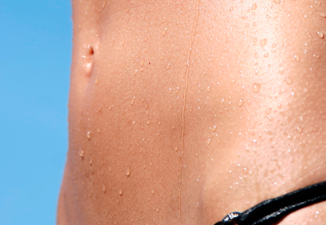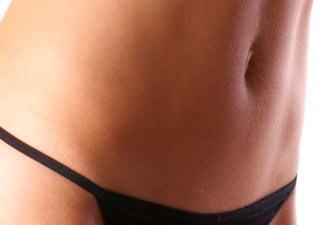
Stretch Mark Treatments

Facts
- Average Treatment Cost
- $4,000-$15,000
- Procedure Time
- 2-5 hours
- In/Outpatient
- Depends on extent of surgery
- Anesthesia
- General
- Recovery Time
- 2-6 weeks back to work; 8-12 weeks return to strenuous activity
- Duration of Results
- Permanent
What you should know
What Are Stretch Mark Treatments
Partially due to genetics, stretch marks are small tears in the dermis that result when the fat or muscle beneath the skin is growing at a faster rate than the skin itself.
“Even though the injury is happening below the surface, we can see these semithick colored and/or textured marks on the surface of the skin because the epidermis cells become full-thickness scar tissue,” says Dr. Barry DiBernardo. If your weight is fairly steady, you may be less likely to develop stretch marks, but there’s no guarantee that they won’t form. They commonly occur during pregnancy.
Ranging in size from fine lines to thick waves, stretch marks can vary in color and are usually red, pink or purple or white or silvery, which transition from darker to lighter with time. Regardless if they are new or old, stretch marks are permanent. “They are all dermal injuries, just with varying degrees of how deep the damage is,” says Dr. Barry DiBernardo.
Red stretch marks: These fresh, new marks are spread out, have just formed and are at the ideal stage for treating. “Their redness comes from prominent blood vessels that are in the growth phase of the scar,” says Dr. Marcene Alexiades-Armenakas.
White stretch marks: Older marks that have been on the skin for at least one year or more.
One thing’s for sure: There is no treatment that can completely eliminate or erase stretch marks but there are treatmetns and procedures that may help reduce their appearance. The earlier you treat them—when they’re darker in color as opposed to when they begin to fade and turn white or silvery—the better your chances of reducing them. The lighter they are, the harder they are to treat because there’s less pigment in the mark, making them less responsive to treatment.
Laser and Light Treatments
If you have bothersome marks that aren’t fading, your doctor can treat them with a laser, which may help reduce their visibility, although any results garnered are usually not permanent. “Using a laser like BBL, SkinTyte and/or a profractional can reduce the appearance of the redness, minimally tighten the skin and improve the texture,” says Dr. Jody Levine.
For stretch marks that are red and obvious, Dr. Barry DiBernardo says that light-based laser treatments, like Intense Pulsed Light (IPL), can help. “They can reduce some of the redness in the skin. Any laser that targets red blood vessels with light should lighten the pigmentation somewhat,” he adds. PDL, or Pulsed Dye Laser, is another option to which red stretch marks respond well.
“It can prevent and eliminate them if you have them treated when they first appear and are red, because it targets the blood vessels and shrinks them, which alters the scar formation process,” says Dr. Marcene Alexiades-Armenakas. (Most doctors do not feel that any laser can prevent or eliminate the stretch marks, only make them slightly less obvious.) The Nd:Yag laser (often used for hair removal) may also be an effective treatment for new stretch marks.
Fractional laser resurfacing and erbium or CO2 lasers are another option. Although these require more downtime, and are a more aggressive form of treatment, they won’t really work on white and mature marks because the lasers can only pick up color and pigment.
Tummy Tuck
To address white stretch marks on the middle to lower part of the stomach, a tummy tuck can be performed, which will permanently get rid of the marks in the area of the removed skin.
“During a tummy tuck, we can excise the portion of skin beset by stretch marks. Pulling and stretching the skin tight also helps to make them less noticeable, especially white ones,” says Dr. Barry DiBernardo.
With a tummy tuck “we can take someone who has a lot of loose skin and a protruding belly and make the skin and stomach completely flat, smoother and free of many of the stretch marks,” says Dr. Leonard Tachmes.
A full tummy tuck requires a hip-to-hip incision in order to tighten the entire abdomen and remove extra skin (and the stretch marks that reside there) in the front. Women who gain an excessive amount of weight during pregnancy may also be left with extra skin on the sides of the abdomen, which may require a more extensive body lift procedure.
Also should add that any other surgeries that excise skin with stretch marks may result in improvement.
Prescription Retinoid
Prescription retinoid creams like Retin-A have been shown to fade new, red stretch marks. They work by stimulating both collagen production and the rate at which your skin turns over, bringing new, fresh skin to the surface.
Just keep in mind that retinoids should be avoided while breastfeeding, but begin applying them immediately after weaning the baby. As with light-based treatments, it’s best to use retinoids when the stretch marks are still red or purple to maximize results.
Just like when retinol is used on the face (you’ll want to use a little more than what you use on your face), there may be some dryness and peeling, and the results, according to Dr. Alexiades-Armenakas, are only minimal at best.
Are they for me
Women who have stretch marks after pregnancy or dramatic weight gain or loss. “If you have a lot of stretch marks, hanging skin, and you’ve had a C-section, you’ll need to consider a tummy tuck,” says West Orange, NJ, plastic surgeon Mokhtar Asaadi, MD. “If you pinch the skin on the lower abdomen and your belly button becomes distorted, you probably need a full tummy tuck. But, if you pinch that same area and the belly button still looks good—without too much wrinkling—then you may be a good candidate for a mini tummy tuck.”
Who they are for
A tummy tuck is for anyone who wants to permanently remove white stretch marks.
Laser and light treatments are for anyone who wants to permanently remove red stretch marks.
Who they are not for
Retinoids should not be used by women who are breastfeeding.
Those who are considering getting pregnant or having more children.
What to Expect With Stretch Mark Treatments
With laser treatments, depending on how dark and concentrated your stretch marks are, you may see a lightening effect in one treatment, but usually several sessions are necessary, and the results may be temporary.
Post tummy tuck surgery, stretch marks on the lower part of the stomach will be gone, and those higher up will be less conspicuous since the skin will be pulled taut.
Post-Treatment Care: Stretch Mark Treatments
Post-treatment care for stretch mark treatments varies depending on the procedure you have done. A tummy tuck will require far more downtime and recovery than laser and light treatments.
Inside Tips
As of late, there is no one proven way of fully preventing stretch marks. “It’s best to keep any weight changes slow and steady and to avoid hormone therapies, including oral contraceptives, if there is a strong family history of stretch marks,” says Dr. Alexiades-Armenakas.
- Keeping the skin well hydrated and using collagen-stimulating topical products may also help to some degree.
- Massaging the skin with a massage brush can increase circulation.
- Eat foods rich in vitamins C and E and zinc, which are all known to increase collagen production and aid in supple skin.







